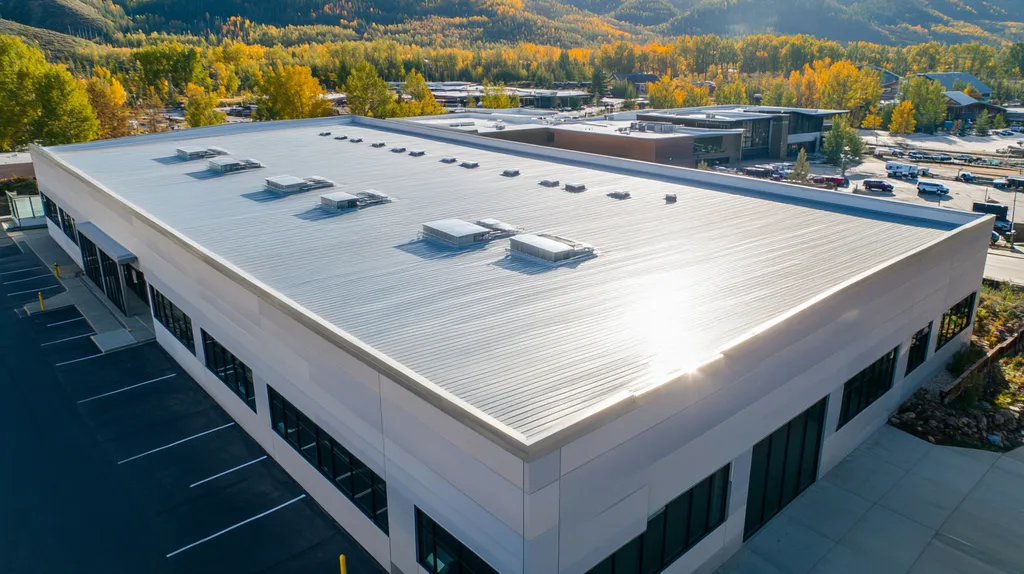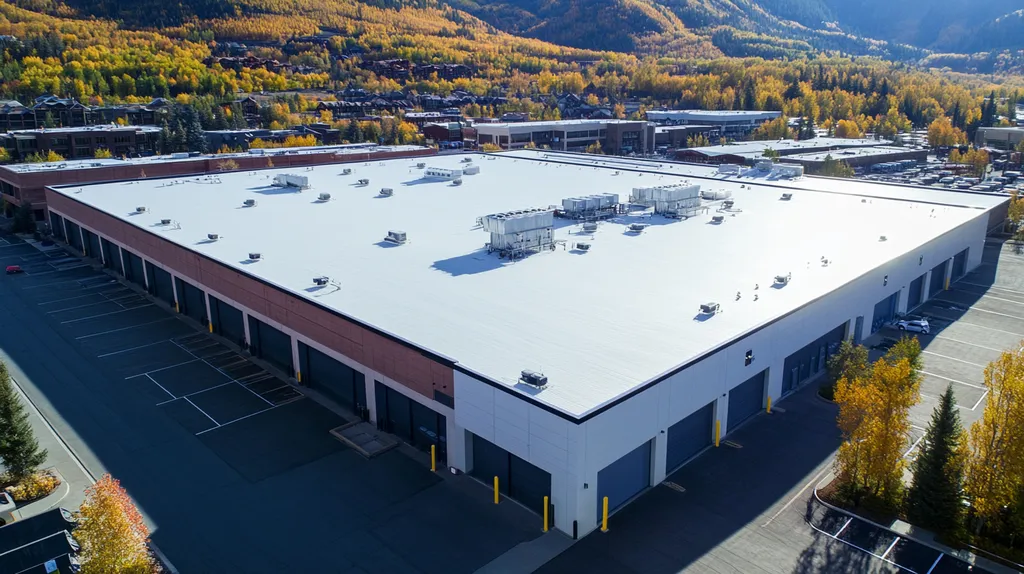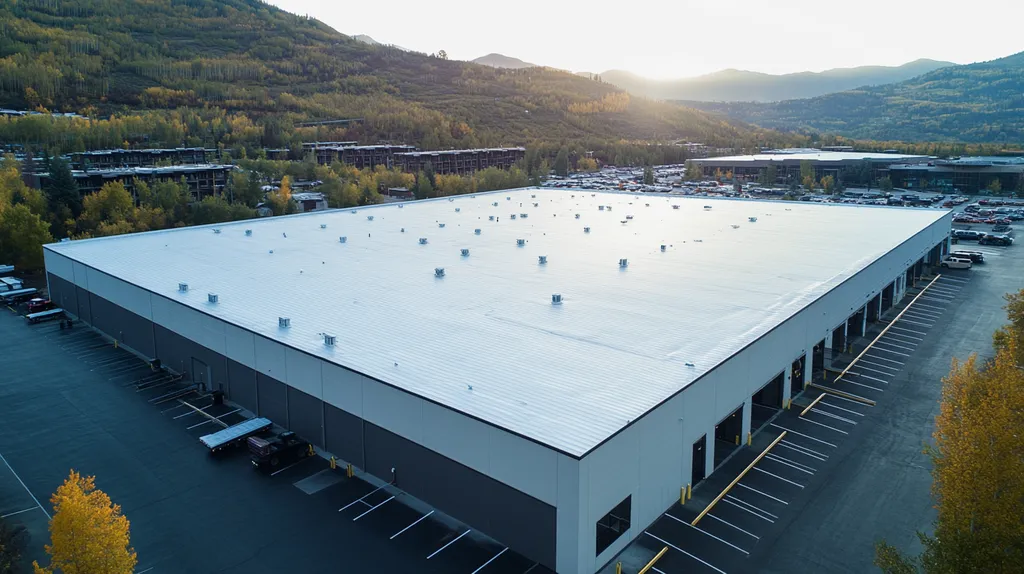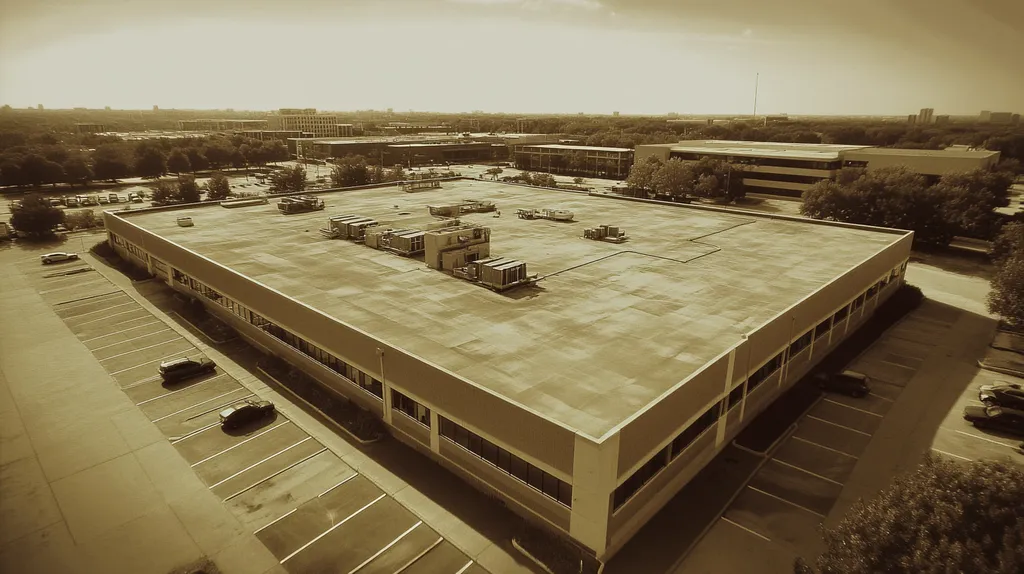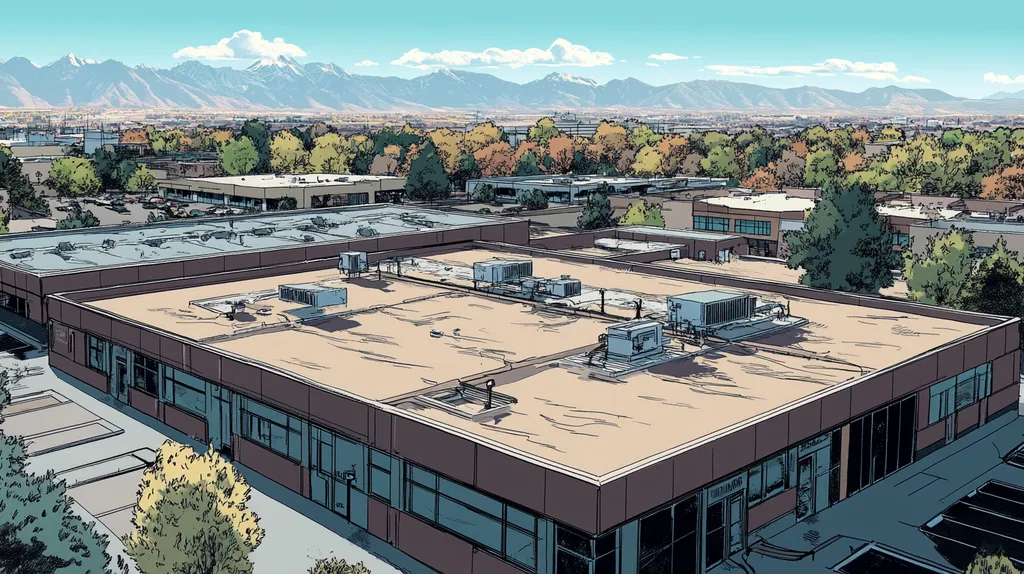Welcome to today’s Battle Royale featuring two roofing heavyweights: “Cool Roof Coatings” in the east corner versus “Traditional Roof Coatings” in the west!
Tonight’s showdown pits these contenders against each other across six punishing rounds designed to test every aspect of their performance for Climate Effects on Commercial Roof Systems.
At stake? Millions in potential costs, decades of building protection, and the critical performance demands of modern commercial and industrial facilities.
Our professional judging panel will evaluate each round on technical merit, real-world performance, and value delivery. After all six rounds, we’ll declare our ultimate champion.
Ladies and gentlemen, facility managers and building owners… it’s time to rumble!
ROUND 1: INITIAL COSTS & INSTALLATION
Commercial property owners face a critical inflection point in roofing decisions as climate change intensifies. The right coating choice can mean the difference between optimal building performance and escalating energy costs. Understanding the financial implications of cool roof versus traditional coatings has never been more urgent, especially as new technologies reshape installation requirements and project timelines.
Material Expenses
Initial material costs represent a significant portion of any commercial roofing project. Cool roof coatings command premium prices compared to traditional options, reflecting their advanced formulations and enhanced performance capabilities.
Recent innovations in cool roof technology demonstrate promising returns on investment. Chemical & Engineering News reports that next-generation chameleon coatings can reduce annual energy costs by approximately 20% compared to conventional roof paint. (source: Chemical & Engineering News)
Traditional coatings offer lower upfront costs but lack the energy-saving properties of their cool roof counterparts. This cost differential narrows significantly when considering long-term operational savings.
While the initial investment is higher for cool roof coatings, their superior energy efficiency creates substantial cost recovery potential. Therefore, cool roof coatings hold the ADVANTAGE in material value proposition.
Installation Complexity
Installation procedures directly impact project success and long-term performance. Cool roof coatings require precise application conditions and specialized equipment to achieve optimal results.
Contractors must maintain strict temperature and humidity controls during cool roof coating application. This precision demands additional preparation time and may require specialized training or certification.
Traditional coatings benefit from widespread contractor familiarity and more forgiving application parameters. Most roofing crews can apply these materials efficiently without additional training.
Given the simpler application process and broader contractor availability, traditional coatings claim the ADVANTAGE in installation complexity.
Project Timeline
Project duration affects both building operations and bottom-line costs. Cool roof coating installations typically require longer preparation periods and specific environmental conditions for proper curing.
Weather dependencies and precise application requirements can extend cool roof coating projects by several days compared to traditional methods. This extended timeline may impact tenant operations and facility accessibility.
Traditional coatings offer more flexible application windows and faster completion times. Their established application processes and shorter curing periods minimize disruption to building operations.
With faster completion times and fewer scheduling constraints, traditional coatings secure the ADVANTAGE in project timeline considerations.
ROUND 1 RESULTS: Traditional Coatings WIN
ROUND 2: DURABILITY & LIFESPAN
As climate patterns become more extreme, the durability requirements for commercial roofing systems have reached critical importance. Recent data shows that roof replacement costs have increased by 30% in the last five years, making longevity a key factor in total ownership costs.
Understanding how different coating types respond to environmental stressors can mean the difference between a roof that lasts decades and one that requires premature replacement. This distinction becomes even more crucial as weather patterns continue to intensify.
The Impact of UV Exposure
UV radiation represents one of the most persistent threats to roof coating integrity. Traditional coatings typically absorb these rays, leading to molecular breakdown and eventual coating failure.
Cool roof coatings incorporate advanced UV-reflecting technologies that significantly reduce surface degradation. Their specialized pigments and polymers maintain structural integrity even under intense solar exposure.
Chemical & Engineering News reports that next-generation cool coatings can reduce thermal stress while delivering 20% energy savings compared to conventional roofing materials. (source: Chemical & Engineering News)
Given their superior UV resistance and reduced thermal loading, cool roof coatings claim the ADVANTAGE in this category.
Resistance to Weathering
Moisture penetration and freeze-thaw cycles pose significant challenges to coating longevity. Traditional coatings often develop microscopic cracks that allow water infiltration, leading to coating separation and substrate damage.
Cool roof coatings utilize advanced moisture-resistant polymers that maintain their protective properties even under harsh conditions. Their superior elasticity allows them to expand and contract without compromising their protective barrier.
This enhanced weather resistance translates to fewer repairs and longer service life in challenging climates. For this reason, cool roof coatings secure the ADVANTAGE in weathering resistance.
Temperature Regulation and Lifespan
Daily temperature fluctuations create thermal stress that can accelerate coating breakdown. Traditional coatings absorb and retain heat, subjecting the roof system to extreme temperature cycling.
Cool roof coatings minimize thermal absorption, reducing the temperature differential between day and night. This moderation of thermal cycling helps preserve both the coating and the underlying roof structure.
By maintaining more stable roof temperatures, cool coatings significantly extend system longevity. The ADVANTAGE in temperature regulation clearly belongs to cool roof coatings.
ROUND 2 WINNER: Cool Roof Coatings
ROUND 3: PERFORMANCE FACTORS
Performance factors have become increasingly critical as climate change intensifies the demands on commercial roofing systems. Recent data shows that poor-performing roofs can increase building energy consumption by up to 40% while accelerating structural deterioration. The stakes are particularly high for facility managers trying to balance operational costs with building longevity.
Durability under Extreme Weather
The frequency and intensity of extreme weather events pose unprecedented challenges for commercial roofing systems. Heat waves, severe storms, and rapid temperature fluctuations test the limits of coating resilience and protective capabilities.
Cool roof coatings incorporate advanced polymers and reflective compounds that maintain their protective properties even under harsh conditions. Their ability to reflect UV radiation and resist thermal shock helps prevent premature degradation.
Traditional coatings often struggle with thermal cycling and UV exposure, leading to accelerated aging and potential failure points. Their absorption of solar radiation creates additional stress on both the coating and underlying substrate.
Given their superior weather resistance and thermal stability, cool roof coatings claim the ADVANTAGE in durability.
Energy Efficiency
Cool roof coatings significantly reduce heat absorption, lowering indoor temperatures and decreasing air conditioning demands. Their reflective properties help maintain consistent internal temperatures while reducing mechanical system strain. (source: Castagra)
Traditional coatings absorb and retain more solar heat, contributing to higher cooling costs and increased energy consumption. This heat retention can create uncomfortable indoor conditions and strain HVAC systems.
The superior thermal performance of cool roof coatings delivers measurable energy savings and improved occupant comfort. For these reasons, cool roof coatings secure the ADVANTAGE in energy efficiency.
Long-Term Maintenance Requirements
Maintenance demands directly impact operational costs and facility management resources. Regular inspections, repairs, and periodic recoating all factor into total ownership expenses.
Cool roof coatings typically require less frequent maintenance due to their enhanced durability and resistance to environmental damage. Their superior weather resistance helps maintain protective properties longer, reducing intervention frequency.
Traditional coatings often need more frequent maintenance and repairs due to accelerated weathering and UV damage. This increased maintenance burden creates additional labor costs and potential disruption to building operations.
With lower maintenance requirements and extended service intervals, cool roof coatings claim the ADVANTAGE in long-term maintenance.
ROUND 3 WINNER: Cool Roof Coatings
ROUND 4: MAINTENANCE REQUIREMENTS
Maintenance decisions for commercial roofing systems have become increasingly critical as extreme weather events intensify. Poor maintenance strategies can lead to premature coating failure, resulting in expensive repairs and potential structural damage. With roof replacement costs rising 15-20% annually, choosing a coating system with optimal maintenance characteristics is more crucial than ever.
Inspection Requirements
Regular inspections form the cornerstone of effective roof maintenance. Cool roof coatings utilize advanced polymers that maintain their reflective properties longer, requiring less frequent visual inspections to verify performance.
A range of cool roof coatings now available can significantly reduce solar heat gain, minimizing thermal stress and extending intervals between detailed inspections. Chemical & Engineering News reports these coatings can deliver year-round energy savings while maintaining their protective properties longer than traditional options. (source: Chemical & Engineering News)
Traditional coatings typically require more frequent inspections due to accelerated weathering and higher susceptibility to UV damage. Their absorption characteristics lead to faster degradation and more intensive monitoring needs.
With reduced inspection frequency and longer performance stability, cool roof coatings claim the ADVANTAGE in inspection requirements.
Cleaning and Surface Maintenance
Surface cleanliness directly impacts coating performance and longevity. Cool roof coatings maintain their reflective properties better when clean, but their smooth surface characteristics make cleaning procedures simpler and more effective.
These coatings often feature self-cleaning properties that help prevent dirt accumulation and biological growth. Their advanced formulations resist staining and maintain reflectivity even with minimal maintenance.
Traditional coatings tend to accumulate more surface contamination and require more aggressive cleaning methods. Their rougher surface texture can trap debris and make thorough cleaning more challenging.
Given their superior self-maintaining properties and easier cleaning requirements, cool roof coatings secure the ADVANTAGE in surface maintenance.
Repair Complexity
The complexity of repairs significantly impacts maintenance costs and building operations. Cool roof coatings typically offer simpler repair solutions, with many allowing spot repairs that seamlessly blend with existing coverage.
Their advanced formulations provide better adhesion and compatibility with repair materials. This characteristic reduces the scope of repair work and minimizes disruption to building operations.
Traditional coatings often require more extensive preparation and larger repair areas to ensure proper adhesion. Their repair procedures frequently demand complete removal and reapplication in affected areas.
With simpler repair procedures and better material compatibility, cool roof coatings claim the ADVANTAGE in repair complexity.
ROUND 4 WINNER: Cool Roof Coatings
ROUND 5: SUSTAINABILITY CREDENTIALS
Climate change has dramatically elevated the importance of sustainable roofing choices for commercial properties. With buildings accounting for 40% of global energy consumption, roofing decisions now directly impact both environmental footprint and operational costs. The EPA estimates that poor roofing choices can increase cooling costs by up to 35% while contributing significantly to urban heat islands.
Environmental Impact
The environmental footprint of roofing materials extends far beyond their manufacturing process. Cool roof coatings incorporate advanced reflective technologies that significantly reduce heat absorption and urban heat island effects.
A range of cool roof coatings now available can dramatically reduce solar heat gain while providing enhanced temperature control throughout changing seasons. C&EN reports these next-generation solutions are racing to market with improved performance capabilities, aiming to meet increasingly stringent greenhouse gas reduction targets. (source: Chemical & Engineering News)
Traditional coatings lack these advanced environmental benefits, often contributing to increased energy consumption and higher carbon emissions. Their heat-absorbing properties amplify urban heat island effects and strain cooling systems.
Given their superior environmental performance and reduced carbon impact, cool roof coatings claim the ADVANTAGE in environmental impact.
Material Lifecycle Assessment
The complete lifecycle impact of roofing materials significantly affects their sustainability credentials. Cool roof coatings typically require fewer raw materials during manufacturing and generate less waste during installation.
These advanced coatings also demonstrate superior durability, extending their service life and reducing the frequency of replacement. Their enhanced resistance to degradation means fewer materials end up in landfills.
Traditional coatings often require more frequent replacement and generate more waste throughout their lifecycle. Their shorter service life leads to increased material consumption and disposal impacts.
With better durability and reduced waste generation, cool roof coatings secure the ADVANTAGE in lifecycle assessment.
Energy Conservation
Energy efficiency has become a critical metric for commercial property performance. Cool roof coatings dramatically reduce cooling loads through advanced reflective properties and thermal management.
These coatings can lower peak roof temperatures by up to 50°F, translating into substantial energy savings and reduced strain on HVAC systems. Their performance actually improves in hotter conditions when cooling demands are highest.
Traditional coatings absorb and retain heat, increasing cooling requirements and energy consumption. This heat retention creates a cascade of negative effects on building performance and operating costs.
Based on superior energy conservation capabilities, cool roof coatings claim the ADVANTAGE in this category.
ROUND 5 WINNER: Cool Roof Coatings
ROUND 6: SPECIALIZED APPLICATIONS
As climate patterns become increasingly unpredictable, specialized roofing applications have emerged as a critical factor in building performance and sustainability. Recent industry data shows that improper coating selection for specific applications can reduce roof lifespan by up to 40% while increasing energy costs by 25-35%.
The stakes are particularly high for facilities facing extreme weather conditions or unique environmental challenges. Understanding how different coating types perform in specialized applications has become essential for protecting both assets and operational budgets.
Performance in Extreme Heat Zones
Extreme heat zones present unique challenges for commercial roofing systems. Surface temperatures can exceed 175°F during peak summer conditions, creating intense thermal stress on both the coating and underlying structure.
Cool roof coatings excel in these conditions, utilizing advanced reflective technologies that dramatically reduce surface temperatures. Chemical & Engineering News reports that next-generation coatings can adapt to seasonal changes, reflecting more solar energy in summer while helping buildings meet increasingly stringent greenhouse gas reduction targets. (source: Chemical & Engineering News)
Traditional coatings typically absorb and retain heat, accelerating degradation and increasing cooling demands. Their performance deteriorates rapidly under sustained high temperatures, leading to premature failure.
Given their superior heat management capabilities, cool roof coatings claim the ADVANTAGE in extreme heat performance.
Cold Climate Adaptability
Cold climate applications demand exceptional freeze-thaw resistance and moisture management. Rapid temperature fluctuations and ice formation can compromise coating integrity and protective capabilities.
Cool roof coatings maintain flexibility even at low temperatures, helping prevent cracking and delamination. Their advanced polymer structures resist moisture penetration while accommodating thermal movement.
Traditional coatings often become brittle in cold conditions, leading to microscopic cracking and potential water infiltration. However, their darker surfaces can help with snow melt and ice prevention in certain applications.
With better overall cold weather performance but recognizing traditional coatings’ specific benefits, this category results in a TIE.
High-Moisture Environments
Regions with high rainfall or persistent humidity require exceptional moisture resistance. Standing water and constant dampness can accelerate coating breakdown and promote biological growth.
Cool roof coatings incorporate advanced moisture barriers that resist water penetration and algae growth. Their smooth surface characteristics promote better drainage while maintaining reflective properties.
Traditional coatings typically offer less resistance to sustained moisture exposure. Their rougher surfaces can trap water and encourage organic growth, leading to accelerated deterioration.
Based on superior moisture management capabilities, cool roof coatings secure the ADVANTAGE in high-moisture applications.
ROUND 6 WINNER: Cool Roof Coatings
AND THE WINNER IS…
After six grueling rounds of technical evaluation, we have our verdict! With a dominant performance winning FIVE of six rounds, COOL ROOF COATINGS emerges as our undisputed champion!
This heavyweight contender dominated the competition through superior sustainability credentials, outstanding durability, exceptional performance factors, and lower maintenance requirements. Its advanced UV-reflecting technologies and energy-saving capabilities delivered a technical knockout that couldn’t be ignored.
But don’t count Traditional Coatings out completely! This seasoned veteran still packs a punch when it comes to initial costs and installation simplicity. For projects with tight budgets or compressed timelines, Traditional Coatings remains a worthy contender.
IMPORTANT NOTICE: Every building faces unique challenges that can impact coating performance. Local climate conditions, structural characteristics, and specific property requirements all play crucial roles in determining the optimal solution. This analysis provides general guidance but cannot account for all variables. Property owners and managers should consult qualified roofing professionals who can evaluate their specific situation before making final decisions.
Ladies and gentlemen, in the high-stakes arena of commercial roofing, there’s no substitute for matching your facility’s specific needs with the right coating’s strengths. Choose your champion wisely – your building’s future depends on it!
FREQUENTLY ASKED QUESTIONS
Q. What are the initial costs of commercial roof coatings?
A. Initial material costs for commercial roof coatings can vary significantly. Cool roof coatings generally have higher upfront costs due to their advanced technology and energy efficiency benefits. However, traditional options can lead to higher operational expenses over time, making long-term investment analysis crucial.
Q. How does the durability of industrial roof coatings compare?
A. Durability differences among roof coatings are significant due to climate factors. Cool roof coatings often outperform traditional ones in resisting UV exposure and weathering. The right choice can extend the lifespan of your industrial roof significantly, reducing maintenance costs and frequency.
Q. Which type of commercial roof coating performs better?
A. Cool roof coatings provide superior performance in terms of energy efficiency and durability. They excel in extreme weather conditions, significantly reducing heat gain and operational costs. Traditional coatings typically fall short in these crucial performance metrics, especially during hot weather.
Q. What maintenance is required for commercial roof systems?
A. Maintenance for commercial roof systems varies by coating type. Cool roof coatings generally require less upkeep due to their advanced properties, leading to fewer inspections and repairs. Traditional coatings, however, may need more frequent maintenance to address accelerated wear and tear.
Q. How do different coatings impact sustainability in roofing?
A. Sustainability is crucial when selecting roofing materials. Cool roof coatings offer enhanced environmental benefits, such as reduced heat absorption and energy conservation. In contrast, traditional coatings can contribute to higher energy use and carbon emissions, making them less sustainable overall.
Q. Are there benefits to specialized applications of industrial roof coatings?
A. Yes, specialized applications for industrial roof coatings can optimize performance regardless of climate challenges. Cool roof coatings excel in extreme heat and high-moisture environments. Selecting the right coating for specific applications can significantly enhance longevity and operational efficiency.
Q. How do environmental factors influence roof coating choices?
A. Environmental factors like UV exposure, temperature fluctuations, and moisture levels greatly affect roof coating choices. Cool roof options generally handle these challenges more effectively, resulting in longer life and better energy savings. Traditional coatings may not perform as well in changing conditions.

